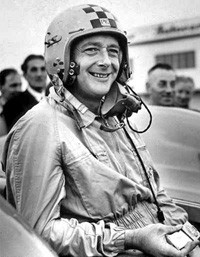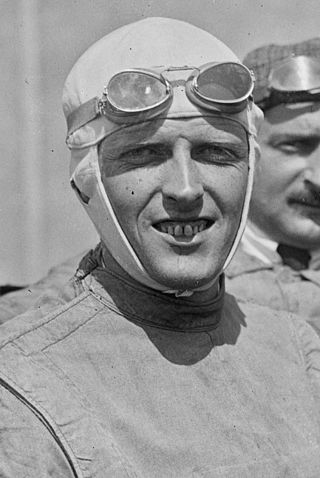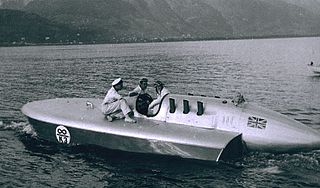Related Research Articles

Donald Malcolm Campbell, was a British speed record breaker who broke eight absolute world speed records on water and on land in the 1950s and 1960s. He remains the only person to set both world land and water speed records in the same year (1964). He died during a water speed record attempt at Coniston Water in the Lake District, England.

Major Sir Malcolm Campbell was a British racing motorist and motoring journalist. He gained the world speed record on land and on water at various times, using vehicles called Blue Bird, including a 1921 Grand Prix Sunbeam. His son, Donald Campbell, carried on the family tradition by holding both land speed and water speed records.

Pendine Sands is a 7-mile (11 km) beach on the shores of Carmarthen Bay on the south coast of Wales. It stretches west to east from Gilman Point to Laugharne Sands. The village of Pendine is close to the western end of the beach.

The world unlimited Water Speed Record is the officially recognised fastest speed achieved by a water-borne vehicle, irrespective of propulsion method. The current unlimited record is 511.11 km/h (317.59 mph), achieved by Australian Ken Warby in the Spirit of Australia in 1978.

Itala was a car manufacturer based in Turin, Italy, from 1904 to 1934, started by Matteo Ceirano and five partners in 1903.

The Rolls-Royce R is a British aero engine that was designed and built specifically for air racing purposes by Rolls-Royce Limited. Nineteen R engines were assembled in a limited production run between 1929 and 1931. Developed from the Rolls-Royce Buzzard, it was a 37-litre capacity, supercharged V-12 capable of producing just under 2,800 horsepower (2,090 kW), and weighed 1,640 pounds (770 kg). Intensive factory testing revealed mechanical failures which were remedied by redesigning the components, greatly improving reliability.

Sir Henry O'Neal de Hane Segrave was an early British pioneer in land speed and water speed records. Segrave, who set three land and one water record, was the first person to hold both titles simultaneously and the first person to travel at over 200 miles per hour (320 km/h) in a land vehicle. He died in an accident in 1930 shortly after setting a new world water speed record on Windermere in the Lake District, England. The Segrave Trophy was established to commemorate his life.

Bluebird Chelsea, at 330–350 King's Road, Chelsea, London, is a Grade II-listed building that is now a noted D&D London restaurant and café, but which had its origins as a noted Art Deco garage complex built for the Bluebird Motor Company, which had connections with Sir Malcolm Campbell.

Arthur Benjamins is a Dutch artist who has progressed from figurative motor sport paintings to Abstract Iconography, taking on the revival of Neoplasticism.

Captain George Edward Thomas Eyston MC OBE was a British engineer, inventor, and racing driver best known for breaking the land speed record three times between 1937 and 1939.

The Bluebird-Proteus CN7 is a gas turbine-powered vehicle that was driven by Donald Campbell and achieved the world land speed record on Lake Eyre in Australia on 17 July 1964. The vehicle set the FIA world record for the flying mile at 403.1 mph (648.7 km/h).

The Napier-Campbell Blue Bird was a land speed record car driven by Malcolm Campbell. Its designer was C. Amherst Villiers and Campbell's regular mechanic Leo Villa supervised its construction.

Blue Bird K4 was a powerboat commissioned in 1939 by Sir Malcolm Campbell, to rival the Americans' efforts in the fight for the world water speed record.

Bluebird Mach 1.1 (CMN-8) was a design for a rocket-powered supersonic land speed record car, planned by Donald Campbell but thwarted by his subsequent death during a water speed record attempt in Bluebird K7 in early 1967.

Kenelm Edward Lee Guinness MBE was an Irish racing driver of the 1910s and 1920s mostly associated with Sunbeam racing cars. He set a new Land Speed Record in 1922. Also an automotive engineer, he invented and manufactured the KLG spark plug. Additionally, aside from motorsport and mechanical interests, he was a director of the Guinness brewing company.

Bluebird K7 is a jet engined hydroplane in which Britain's Donald Campbell set seven world water speed records between 1955 and 1967. K7 was the first successful jet-powered hydroplane, and was considered revolutionary when launched in January 1955. Campbell and K7 were responsible for adding almost 100 miles per hour (160 km/h) to the water speed record, taking it from existing mark of 178 miles per hour (286 km/h) to just over 276 miles per hour (444 km/h). Donald Campbell was killed in an accident with a much modified K7, on 4 January 1967, whilst making a bid for his eighth water speed record, with his aim to raise the record to over 300 miles per hour (480 km/h) on Coniston Water.

Blue Bird or Bluebird is the name of various cars and boats used by Sir Malcolm Campbell, his son Donald and other family members to set land and water speed records.

Mr Whoppit was the teddy bear mascot of Donald Campbell, the land and water speed record holder. Writing in his 2011 book, Donald Campbell: The Man Behind The Mask, journalist David Tremayne described Whoppit as Campbell's "magic talisman".

Blue Bird K3 is a hydroplane powerboat commissioned in 1937 by Sir Malcolm Campbell, to rival the Americans' efforts in the fight for the world water speed record. She set three world water speed records, first on Lake Maggiore in September 1937, then later twice raising her own record.

Jarvis & Sons Limited were South London-based motor dealers for Morris and MG, and latterly coachworks providing special bodies for various car chassis until after World War II.
References
- ↑ Villa, Life with the Speed King
- 1 2 Tremayne, David (2004). Donald Campbell: The Man Behind The Mask. London: Bantam Press. ISBN 978-0-55381-511-5.
- ↑ de Lara, David (2007). Leo Villa's Bluebird Photo Album. Isleworth: Transport Bookman. ISBN 978-0-85184-071-0.